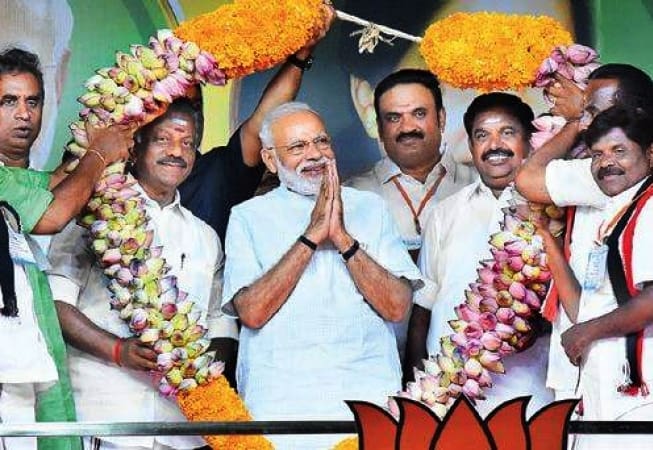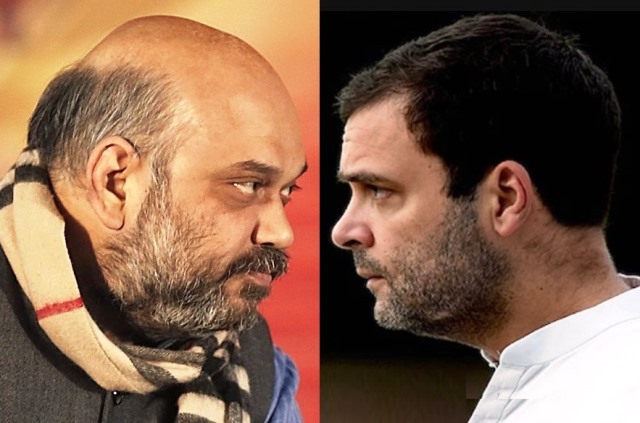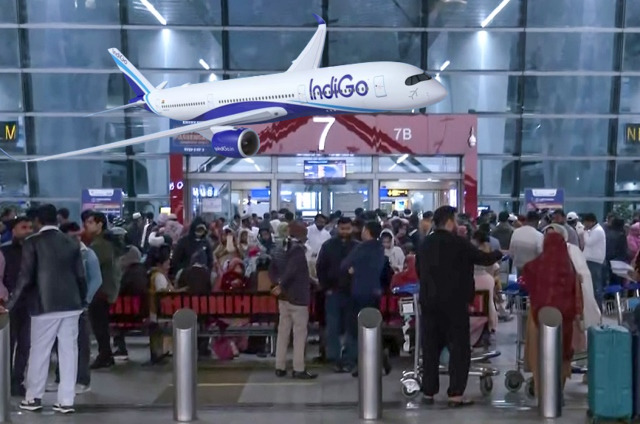
How Long Before Tamil Nadu Falls!
Tamil Nadu along with Punjab is one of the last bastions that has not fallen to the BJP’s nationalism led drive to paint all states with Saffron. Tamil Nadu has resisted imposition of Hindi. It is proudly a Dravidian state with deep suspicions of North Indian Hindus and Brahamins. But how long can Tamil Nadu’s own nationalism hold back a sophisticated and relentless BJP-RSS machine from breaking its resolve? There are signs that other states, such as Kerala and Andhra Pradesh, may be wilting. Can this crushing juggernaut be stopped?
When the Bharatiya Janata Party swept the Lok Sabha election in 2014, its president Amit Shah had directed party cadres they should not rest on their laurels and should instead start work on expanding the party’s footprint in West Bengal and Odisha.
The mission proved to be a resounding success as the saffron party made huge inroads in these two states where it replaced the Congress and the Left parties as the main opposition party in the last Lok Sabha election.
Shah gave a similar clarion call to the BJP rank and file to go into unchartered territory after its resounding victory in the last Lok Sabha election. Having consolidated its position across large parts of the country, Shah said the party should now focus on growing in the Southern states.
The BJP has already swept Karnataka made a significant dent in Telangana and improved its vote share marginally in Kerala though like Tamil Nadu and Andhra Pradesh, it remained immune both to Modi’s personal charm and the BJP’s nationalist and majoritarian agenda.
But this has not deterred the BJP which has drawn up a blueprint for expanding in the Southern region. For instance, party workers have been told to especially target new areas and to reach out to different sections of society in its ongoing membership drive. In addition, the BJP took a calculated decision to appoint Rashtriya Swayamsevak Swayamsewak Sangh ideologue B.L. Santhosh as party general secretary (organization) in place of Ram Lal who has returned to the RSS.
Fluent in Tamil, Telugu and Kannada and an engineer by training, Santhosh is a long-time RSS pracharak who was credited with the formation of the BJP’s first government in Karnataka, his home state. He has also been working in Kerala and it was at his instance that Shah undertook a padayatra in Kerala to protest the spate of political killings.
Having set its eyes on the Southern states, Shah’s game plan is to utilize Santhosh’s organizational skills as well as deep knowledge of the region to ensure that the saffron party is no longer considered a North Indian party here.
However, the Southern states present a mixed bag for the BJP. While it is hoping to inch ahead in Telangana and Kerala, the saffron party faces its biggest challenge in Tamil Nadu.
BJP insiders admit that their attempts to make the Sabarimala Temple controversy in Kerala into an emotive issue like Ayodhya did not pay them electoral dividend and instead it was the Congress which benefited from it in the recent Lok Sabha election. The BJP failed to open its account in this election but party strategists are convinced the party has the potential to grow in “God’s Own Country”. The BJP’s optimism is based on the increase in the party’s vote share, which has now climbed to 13 percent. According to a BJP leader, this will serve as a solid foundation on which they can build upon in the coming years.
“It is our experience that once we have a vote share of 12 percent in any state, it serves as a springboard for the party’s upward climb,” remarked a BJP strategist.
The saffron party is, therefore, paying special attention to Kerala. It was no coincidence that Prime Minister Narendra Modi traveled to Kerala soon after his massive electoral victory to offer prayers at the famous Guruvayur Sri Krishna Temple. The BJP is banking on its Hindutva agenda to wean away the majority Hindu population which has been voting largely for the Left Democratic Front and partially for the Congress-led United Democratic Front which also has a strong base among the Muslims and Christians.
Besides wooing the Hindus, the BJP is also reaching out to the minorities in Kerala, which constitute nearly 45 per cent of the population. Working in this direction, the saffron party recently inducted former Congress MP Abullakutty into its fold in the hope that he can help the BJP dent the Muslim vote. However, this could prove to be a futile exercise as the minorities remain wary of the BJP and are unlikely to shift loyalties easily as proved in the recent general election. The BJP also depended on Alphonse Kannanthanam and former Kerala Congress leader P.C.George to win over the Christians but to little avail.
Though the Hindus preferred to go with the Congress-led UDF in the last Lok Sabha poll, there is no doubt that the majority community, especially the upper castes, are becoming impressed with the BJP’s Hindutva agenda. Despite this, the BJP will not have an easy ride in Kerala given the high literacy rates and the fact that its people have strong ideological roots. More importantly, the BJP is handicapped because it does not have powerful state leaders and a strong organization to take on its well-entrenched opponents.
While the BJP is hoping to work on its weaknesses in Kerala, party insiders admit that it is a long haul for it in Tamil Nadu. While the rest of the country was mesmerized by Modi’s persona and the BJP’s nationalist agenda, Tamil Nadu was a rare state which witnessed anti-Modi protests. The BJP had hoped that the broad alliance it forged with the AIADMK and other smaller parties would help it make inroads in Tamil Nadu but it could not win a single seat here while its vote share is less than four percent.
Besides the fact that like Kerala, the BJP does not have local leaders or a party organization in Tamil Nadu, the people of this Southern state are wary of the saffron party as they believe it seeks to undermine their regional and cultural identity. The strong anti-Hindi protests witnessed in Tamil Nadu each time the BJP attempts to impose the use of Hindi in an indication of the prevailing public sentiment.
Tamil Nadu has always been dominated by strong regional parties and its politics heavily influenced by the anti-Brahmin Dravidian movement. It is not easy for a national party to get a foothold here on its own and, more so, for a party like the BJP which is considered an “upper-caste Brahmin party”. A national party necessarily needs the help of a regional player to register its presence in Tamil Nadu. The Congress was in luck this time as its senior partner, the DMK, was on a strong wicket. The BJP floundered as its allies were weak. From all accounts, the saffron party faces an uphill task ahead here.
“There are several factors which are at play in an election. It is a combination of a strong organization, charismatic leaders, an emotive issue and a critical mass of voters. We have to work on these in the South,” a senior BJP leader rightly pointed out. How long can Tamil Nadu hold the fort against a slick and determined wave?



